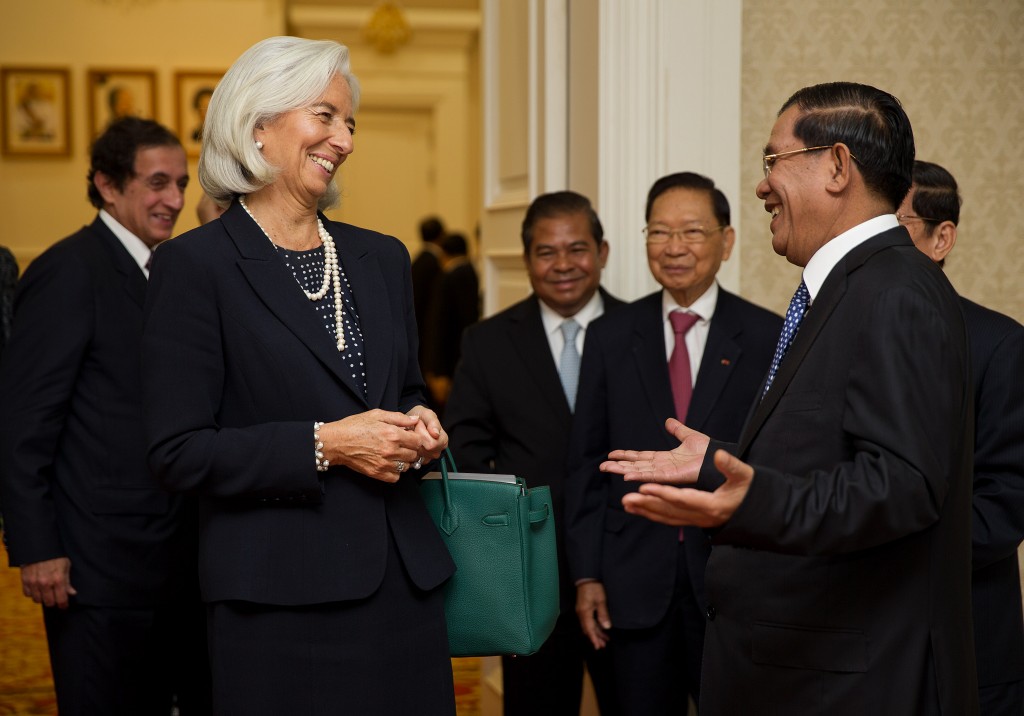
នាយករដ្ឋមន្រ្តីនៃប្រទេសកម្ពុជា ជាមួយនឹងនាយកគ្រប់គ្រងនៃមូលនិធិហិរញ្ញវត្ថុអន្តរជាតិ នៅប្រទេសកម្ពុជា។ រូបភាព ថតដោយមូលនិធិហិរញ្ញវត្ថុអន្តរជាតិ កាលពីថ្ងៃទី២ ខែធ្នូ ឆ្នាំ២០១៣។ ក្រោមអាជ្ញាប័ណ្ណ CC BY-NC-ND 2.0
ប្រព័ន្ធរដ្ឋបាលនៃប្រទេសកម្ពុជា ប្រកាន់យករបបរាជានិយមអាស្រ័យរដ្ឋធម្មនុញ្ញ ក្នុងនោះព្រះមហាក្សត្រមិនមានអំណាចដាច់ខាត ហើយអំណាចរបស់ព្រះមហាក្សត្រត្រូវបានកំណត់ដោយរដ្ឋធម្មនុញ្ញ។ យោងរដ្ឋធម្មនុញ្ញឆ្នាំ១៩៩៣ បើទោះបីព្រះមហាក្សត្រ គឺជា ប្រមុខរដ្ឋ ប៉ុន្តែទ្រង់មានអំណាចតិចតួច បើធៀបនឹងនាយករដ្ឋមន្ត្រី ដែលជាប្រមុខនៃរាជរដ្ឋាភិបាលនៃព្រះរាជាណាចក្រកម្ពុជា។ 1 ខុសពីរបបគ្រប់គ្រងប្រទេសនៅក្រោម រដ្ឋធម្មនុញ្ញឆ្នាំ១៩៤៧ បច្ចុប្បន្ន គ្រប់អំណាចនៃការគ្រប់គ្រងប្រទេសទាំងអស់មិនមែនជារបស់ព្រះរាជាទេ ប៉ុន្តែជារបស់ប្រជាពលរដ្ឋខ្មែរ។2
គណៈរដ្ឋមន្ត្រី គឺជារាជរដ្ឋាភិបាលនៃព្រះរាជាណាចក្រកម្ពុជា (តំណាងឱ្យអង្គនីតិប្រតិបត្តិ)។ ស្ថាប័នកំពូលនៃអំណាចនីតិប្រតិបត្តិមួយនេះ មានសមាសភាព នាយករដ្ឋមន្ត្រី ឧបនាយករដ្ឋមន្ត្រី ទេសរដ្ឋមន្ត្រី រដ្ឋមន្ត្រី និងរដ្ឋលេខាធិការ។ សមាជិករដ្ឋាភិបាលភាគច្រើន គឺជាប្រធានក្រសួង និងស្ថាប័នជាតិនានា ។ សមាជិករាជរដ្ឋាភិបាលទាំងនោះ គឺជាអ្នកទទួលខុសត្រូវលើការអនុវត្តច្បាប់និងបទបញ្ជា ព្រមទាំងគោលនយោបាយដែលសភាបានអនុម័តនិងព្រះមហាក្សត្រប្រកាសឱ្យប្រើ ឬដាក់ចេញដោយរាជរដ្ឋាភិបាល។
ប្រជាធិបតេយ្យសេរីពហុបក្ស គឺជាគោលការណ៍យកមកប្រតិបត្តិសម្រាប់ប្រព័ន្ធនយោបាយនៃប្រទេសនេះ។3 ជាមួយនឹងការចូលរួមការបោះឆ្នោតដោយគណបក្សនយោបាយជាច្រើន ប្រជាពលរដ្ឋខ្មែរបោះឆ្នោតជ្រើសតាំងតំណាងរបស់ពួកគេ ទោះដោយផ្ទាល់ក្តី ឬដោយប្រយោលក្តី។ ជាការពិតណាស់ ខណៈពេលដែលប្រព័ន្ធសភានៃប្រទេសនេះ ដើរតាមទ្វិសភានិយម មានតែសមាជិករដ្ឋសភាប៉ុណ្ណោះដែលត្រូវបានបោះឆ្នោតជ្រើសតាំងដោយផ្ទាល់ពីប្រជាពលរដ្ឋ ហើយសមាជិកព្រឹទ្ធសភាត្រូវបានបោះឆ្នោតជ្រើសតាំងដោយមិនផ្ទាល់។4 សភាទាំងពីរថ្នាក់នេះ បង្កើតបានជាសភា នៃប្រទេសកម្ពុជា។
ចាប់តាំងពីការស្តារឡើងវិញនូវរបបរាជានិយមជាលើកទី២មក មានការបោះឆ្នោតជាសកល និងដោយផ្ទាល់ចំនួន៥លើករួចមកហើយ។5 នេះមានន័យថា រដ្ឋសភា និងរដ្ឋាភិបាលនៃប្រទេសកម្ពុជា គឺស្ថិតនៅអាណត្តិទី៥របស់ខ្លួន។ យ៉ាងណាមិញ ព្រឹទ្ធសភា ទើបតែបានឆ្លងកាត់ការបោះឆ្នោតរបស់ខ្លួនចំនួនពីរលើកប៉ុណ្ណោះ ប៉ុន្តែបច្ចុប្បន្នកំពុងបំពេញកិច្ចការសម្រាប់អាណត្តិទី៣របស់ខ្លួន។6 ខណៈពេលដែលព្រឹទ្ធសភាមានអាណត្តិ៦ឆ្នាំ រដ្ឋសភាមានអាណត្តិ៥ឆ្នាំ។
ព្រះរាជាណាចក្រកម្ពុជា គឺជារដ្ឋទោល និងមិនអាចបំបែកបាន។ ខណៈពេលដែលរដ្ឋបាលដែនដីនៃប្រទេសនេះ ត្រូវបានបែងចែកជារាជធានី ខេត្ត ក្រុង ស្រុក ខណ្ឌ ឃុំ និងសង្កាត់ ការរៀបចំ និងការប្រព្រឹត្តទៅនៃរដ្ឋបាលខេត្ត និងដែនដី នៅតែស្ថិតក្រោមការត្រួតពិនិត្យ ដោយរដ្ឋបាលថ្នាក់ជាតិ តាមរយៈក្របខណ្ឌច្បាប់ ឬក្របខណ្ឌស្ថាប័ន។7 ភូមិ មិនត្រូវបានទទួលស្គាល់ ជាផ្នែកនៃរដ្ឋបាលដែនដីនៃប្រទេសកម្ពុជាទេ។
គ្រប់បទដ្ឋានក្រោមច្បាប់ ដែលត្រូវបានចេញដោយរដ្ឋាភិបាល និងក្រសួង និងសា្ថប័នរដ្ឋាភិបាល តែងមានឋានានុក្រមខ្ពស់ជាងបទដ្ឋានចេញដោយរដ្ឋបាលដែនដី។ ដូចគ្នានេះ នៅរដ្ឋបាលមូលដ្ឋាន ក្រសួងនិងស្ថាប័នរដ្ឋាភិបាល មានរចនាសម្ព័ន្ធគ្រប់គ្រងរបស់ខ្លួននៅតាមបណ្តាខេត្តជាមន្ទីរ និងបណ្តា ក្រុង ឬស្រុក ជាការិយាល័យ ។ ហេតុដូច្នេះ រដ្ឋបាលដែនដីនៅគ្រប់កំរិត អនុវត្តសិទ្ធិអំណាច ក្នុងនាមរដ្ឋបាលថ្នាក់ជាតិ។
ទាក់ទងនឹងរដ្ឋបាលថ្នាក់ជាតិ
បច្ចុប្បន្នភាពចុងក្រោយ ថ្ងៃទី ២៩ ខែ កញ្ញា ឆ្នាំ២០១៥
ឯកសារយោង
- 1. រដ្ឋធម្មនុញ្ញ មាត្រា៧។
- 2. រដ្ឋធម្មនុញ្ញ មាត្រា៥១ថ្មី ។
- 3. ដូចខាងដើម
- 4. រដ្ឋធម្មនុញ្ញ ជំពូកទី៧ និងជំពូកទី៨
- 5. ការបោះឆ្នោតជាតិជ្រើសតាំងសមាជិករដ្ឋសភា ត្រូវបានរៀបចំឡើងចំនួនប្រាំដងរួចមកហើយនៅឆ្នាំ ១៩៩៣, ឆ្នាំ១៩៩៨, ឆ្នាំ២០០៣, ឆ្នាំ២០០៨, និង ឆ្នាំ២០១៣។ រដ្ឋសភានៃព្រះរាជាណាចក្រកម្ពុជា “សាវតារដ្ឋសភា”។ រៀងរៀងឡើងកាលពីឆ្នាំ២០១៣។ ចូលអាននៅថ្ងៃទី ០៣ ខែសីហា ឆ្នាំ២០១៥។ http://nac-kh.org/group-article/3
- 6. ការបោះឆ្នោតជាតិជ្រើសតាំងសមាជិកព្រឹទ្ធសភា ត្រូវបានរៀបចំឡើងចំនួនពីរដងរួចមកហើយនៅក្នុងឆ្នាំ២០០៦ និងឆ្នាំ២០១២។ គួរកត់សម្គាល់ថា ស្ថាប័ននេះ ទើបនឹងត្រូវបានបង្កើតឡើងនៅក្នុងឆ្នាំ១៩៩៨ បន្ទាប់ពីការបោះឆ្នោតជាតិនៃរដ្ឋសភា ក្នុងនីតិកាលទី២ ហើយសមាជិកព្រឹទ្ធសភា ក្នុងនីតិកាលទី១ ត្រូវបានតែងតាំងទាំងអស់ ដោយមិនមានការបោះឆ្នោតទេ។ ព្រឹទ្ធសភា “ប្រវត្តិសង្ខេបនៃសភាកម្ពុជា”។ ធ្វើបច្ចុប្បន្នភាពចុងក្រោយនៅថ្ងៃទី ១២ ខែមករា ឆ្នាំ២០១៨។ ចូលអាននៅថ្ងៃទី ១៩ ខែមិថុនា ឆ្នាំ២០១៥។ https://senate.gov.kh/kh1/templates/protostar/about-senate.php
- 7. រដ្ឋធម្មនុញ្ញ មាត្រា១៤៦ថ្មី (មួយ)។ រដ្ឋធម្មនុញ្ញឆ្នាំ១៩៩៣ ត្រូវបានធ្វើវិសោធនកម្មចុងក្រោយបំផុតនៅឆ្នាំ ២០១៤។

